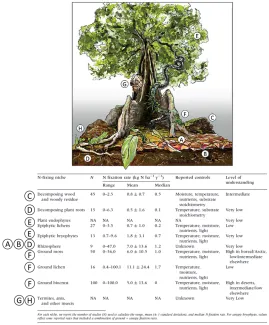A new study provides insight into our current knowledge of nitrogen fixation by non-symbiotic organisms living in soil, litter, decomposition wood, lichens, mosses, and insects.
Inputs of biologically available nitrogen to ecosystems are important to carbon-nutrient ecosystem feedbacks. Robust quantification of these inputs requires consideration of nitrogen fixation by symbiotic, mutualistic, and free-living organisms. Unfortunately, the latter two ecological niches are poorly understood, despite their potentially ubiquitous presence in both unmanaged and agricultural ecosystems. In a recently published article, Cleveland and coauthors synthesized published rates of “cryptic” nitrogen fixation—that is, nitrogen fixation performed by mutualistic and free-living organisms found in soil, plant litter, decomposing roots and wood, lichens, mosses, and insects. The authors conducted a literature review to explore rates, patterns, and controls of cryptic nitrogen fixation. The resulting analysis demonstrated that, as is common with symbiotic nitrogen fixation, cryptic nitrogen fixation rates are highly variable. Nitrogen inputs range from near zero to more than 20 kg ha−1 y−1. Such large variation underscores the need for more comprehensive measurements of cryptic nitrogen fixation and identification of the factors that constrain cryptic nitrogen fixation rates. The authors highlighted several challenges, opportunities, and priorities in this important research area and proposed a conceptual model of an interacting hierarchy of biophysical and biogeochemical controls over nitrogen fixation. Next steps for this project include scaling rates of nitrogen fixation for cryptic nitrogen-fixers alongside symbiotic nitrogen-fixers to estimate global rates of biological nitrogen fixation. The resulting data product will provide an important benchmark for nutrient-enabled earth system models. This research was supported by the USGS Powell Center, and coauthor Verity Salmon participated with support from NGEE Arctic.
Citation: Cleveland, C. C., et al. 2022. “Exploring the role of cryptic nitrogen fixers in terrestrial ecosystems: A frontier in nitrogen cycling research.” Ecosystems 25: 1653–1669. https://doi.org/10.1007/s10021-022-00804-2.
Artist E. Harrington’s representation of a tropical forest illustrating many of the cryptic N-fixing niches present in terrestrial ecosystems. These include (A) leaf litter, (B) soil, (C) decaying wood, (D) roots and rhizosphere, (E) plant epiphytes, (F) mosses and lichens (cryptograms), (G) termites, and (H) leafcutter ant mounds. The table beneath outlines synthesized nitrogen fixation rates, reported controls, and levels of understanding for these cryptic nitrogen-fixing niches.
For more information, please contact:
Verity Salmon
salmonvg@ornl.gov

